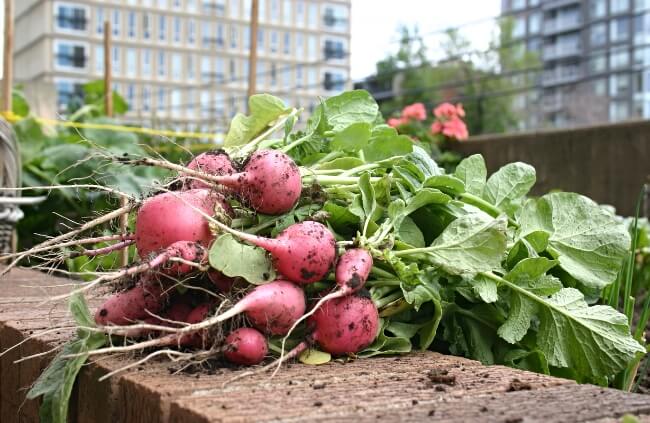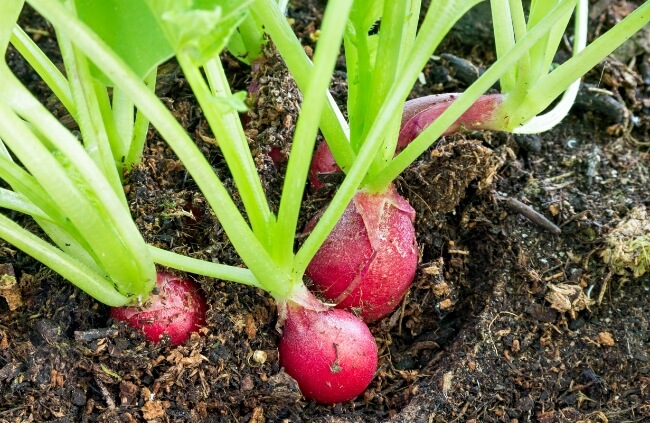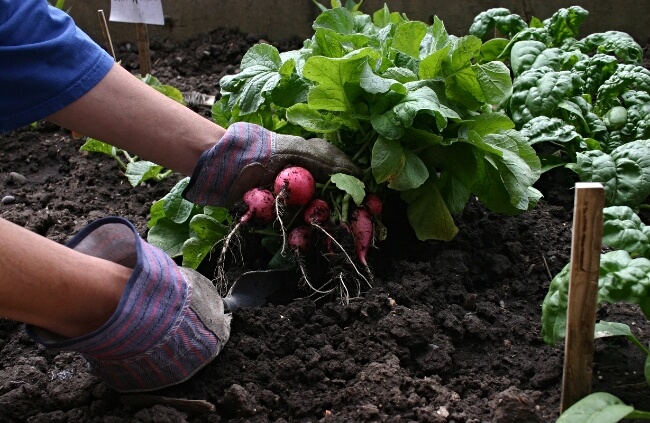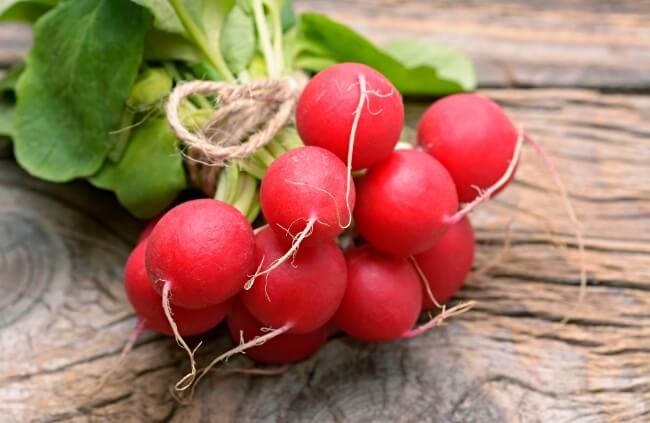Radishes grow best in spring and autumn in Australia but can be grown all year round. If you’ve ever found that your summer radishes are tough, and your winter radishes are sluggish, this guide will bring the best out of your plot.
More...

Family: | Brassicaceae |
|---|---|
Genus: | Raphanus |
Species: | R. sativus |
Common names: | Radish |
Origin: | Southeast Asia |
Location: | Outdoor |
Type: | Edible root vegetable |
Growth: | 10cm x 10cm (1m high in flower) |
Sun requirements: | Full sun or light shade |
Foliage colour: | Green |
Flower colour: | White to pale pink or purple |
Flowering: | Mainly in summer but can flower year-round in ideal conditions |
Edible parts: | All parts are edible |
Maintenance level: | Low |
Poisonous for pets: | Non-toxic to pets |
What are Radishes?
Radishes are a useful, fast-growing root crop, in the brassica (cabbage) family. Every part of the plant is edible, and the flowers are actually quite sweet.
The swollen, typically red, root of radishes are the prize crop, and when grown in ideal conditions, they offer fresh, zesty spice, and a mustardy hit to salads. And even though radishes are a varied crop, with hundreds of cultivars, they all generally enjoy the same sorts of conditions; well-drained, rich soil, and a sprinkle of lime never does any harm.
Identifying Radishes
Radishes are easy to identify, but some varieties are easily mistaken for other root brassicas like turnips (in colour, size and flavour) while others are commonly mistaken for carrots based solely on looks (If you’ve ever read Peter Rabbit, did you know he was holding a radish in that cover picture, not a carrot!).
The major difference between radishes and carrots is their leaf. Elongated red radish roots are also smoother, with a more drastic taper to the thin root at the end. Carrots typically have a very fine root at the end of their tap root, and fibrous roots growing from the main root too, whereas radishes will always have just one larger round root, and a neat tapered end.
Turnips and radishes are harder to distinguish. Both are brassicas, but turnips are Brassica rapa, and radishes are Raphanus sativus. Turnips tend to have larger roots, and while some cultivars are very red, most are pale purple, while most radishes are rich crimson.
Turnip leaves are also larger than radishes, and their flavour is milder. Radishes have much more of that hot mustard flavour than other brassica roots.
Natural Habitat of Radishes
Raphanus sativus, the scientific name for the radish, is thought to have originated in Southeast Asia, but like most brassicas, its origins are quite unclear, and the earliest truly identifiable records of radishes are from cultivated plants, not wild ones, meaning they could have been brought in intentionally, rather than as a native crop.
Today though, radishes are best defined by their habitat types, rather than geography as they grow well all over the world thanks to their ability to withstand frost and tolerate hot summers.
Radishes Common Uses

Radishes are an edible crop nearly always grown and harvested from their spicy roots. But the leaves are edible and act as a great substitute for leafy spring cabbages, and can be harvested over and over again if you don’t plan on picking the roots.
If your radishes bolt due to hot summers and not getting enough water, the flowers are mildly sweet, and delicately spiced, making a great garnish for salads or soups, and the seeds have an even more intense flavour than the roots.
There are also uses for radish seed oil, but it isn’t fit for culinary use like its close relative rape seed or mustard seed oil. Radish seed oil has an incredibly high oil content and is easy to extract through cold pressing, with the potential as a useful biofuel.
Best Radishes to Grow in Australia
As well as this guide to growing radishes, we’ve published an extremely useful list of the best radishes to grow in Australia. Radishes are massively varied crops, with a rainbow of colours to choose from, each with a different flavour profile, spice level, and size.
Read about the best radish varieties to grow in Australia here for the best tips on different cultivars, but if you just want to stick to the most popular, why not try some of these below:


Get Your Free Guide:
Master Growing Australian Natives eBook
A Must Have Complete Guide for Every Australian Garden
Get Your Free Guide:
Master Growing Australian Natives eBook
A Must Have Complete Guide for Every Australian Garden
1. French Breakfast Radish
By far the most popular radish to grow, not just in Australia, but across the globe, is French Breakfast. These small, spicy radishes pack a punch and have a beautiful two-tone skin that makes them a truly gorgeous addition to salads, or thinly sliced in soups.
French Breakfast radishes can grow all year round in Australia but prefer spring and autumn when you can expect a crop in about six weeks.
2. Mars Radish
Mars is a really fast-growing radish, typically growing from seed to plate in under a month, and around 6 weeks in winter. It can cope with most weather conditions that Australia has to throw at it, and while its flavour is slightly milder than others, it's just as beautiful.
3. Fuego Radish
Fuego is an elongated radish with excellent disease resistance and beautifully scarlet-toned skin. If you’ve ever had trouble growing radishes in the past, try to get your hands on some Fuego radish seeds, as they have a great success rate and crop in about 6 weeks at most times of the year.
How to Grow Radishes in Australia
Radishes are a temperate climate crop. They like mild summers, warm winters, and whatever spring and autumn can throw at them. That means that mid-summer is the only truly challenging time to grow them in Australia, but as long as you give them plenty of water and protect them from the hottest summer sun, you can harvest your spicy roots every single day of the year.
Growing Radishes from Seeds
Propagating radishes is simple; sow the seeds, and wait. You can start radishes off indoors and plant them out later, but they germinate so quickly and develop to maturity in just a few weeks, so sowing directly into the ground or pots that they will stay in is always the best option.
If you do choose to grow radishes from seed in seed trays or modules, use a moisture-retentive but fine-grade compost without any chunky material.
Seed compost or any sieved garden compost will do. Once your radishes are growing strongly plant them out in rows about 5-10cm apart.
If you sow them directly (which we advise) then create 1cm-deep drills in your garden beds, having cleared all weeds first. Space the drills 10cm apart to help with weeding, and sow thinly. Water the bed evenly with a rose on your watering can, or fine spray from the hose so you don’t displace seeds.

When to Sow Radishes
Radishes take 4-8 weeks from sowing to harvest, depending on soil conditions and the time of year. For a regular crop of these easy-going salad veggies, make weekly or fortnightly sowings all year round, adding a granular fertiliser to the bed before each sowing. Harvest in rows so you can keep track of harvest dates.
If you’re growing in pots, or as a catch crop (more on this later), then sow radishes regularly in whatever space you have available, no matter the time of year.
Best Conditions for Growing Radishes
Radishes do best in full sun between early autumn and late spring. In summer, part shade is advisable to avoid the need for constant watering. They will grow in most soil conditions too, but follow the guide below to get your plot ready for these hungry brassicas.
Soil & Drainage
Radish might not be in the brassica genus, but it is in the same family, and just like other brassicas, it’s a much hungrier plant than most guides would have you believe.
They can grow in spent compost, poor soil, and even clay, but if you want really good, flavourful, crisp radishes, then even moisture, well-regulated drainage, and plenty of slow-release fertiliser will noticeably improve your harvest.
Aim for open soil structure by digging plenty of well-rotted manure through the soil at the start of the growing season, or sprinkling generous handfuls of chicken manure pellets onto the soil surface before planting.
Radishes and the wider brassica family also benefit from lime, so a light sprinkling of lime can help to recondition your garden beds before planting radishes.
Light & Temperature
Nearly every guide will tell you that radishes need full sun, but if you’re growing them in the middle of summer in Australia, think again.
Try to protect your radishes from baking sunlight, as this will not only increase how often you need to water, but can trigger them to bolt as well as cause tough, woody roots that are neither pleasant to eat, nor flavourful.
We try to reduce direct summer sun on rows of radishes by inserting a bamboo stake at either end of the northern side of the raised beds we grow them in, then securing translucent netting or fleece to the stakes.
This won’t affect the temperature, rainfall, or anything else, but reduces surface-level evaporation, helping to stop bolting and retaining water.
You don’t need to blow the budget on fleece. There are basic garden fleece online for less than the branded stuff in the shops.
Companion Planting with Radishes
Radishes make an excellent catch crop among other plants, as long as you account for their nutrient needs. Either top up your beds with fresh compost before planting radishes or apply liquid seaweed or another liquid fertiliser once a week after they germinate.
Plant radishes between rows of celery, potatoes, tomatoes, and pretty much any other veggies to get a crop from a small space while you wait for other things to develop.
Pot Growing vs Ground Planting
Radishes grow really well in pots of any size, but they need to be at least 20cm deep so water can drain without sitting around the roots, and provide about 5cm between each radish.
Whether you choose to grow them in pots or directly in the ground, understanding their spacing and drainage needs will help you achieve a bountiful harvest.
How to Care for Radishes
Once radishes start growing, care depends on how and where they’re growing conditions and location. For example, radishes planted as a catch crop will need additional liquid feed, but radishes grown in a well-fed raised bed by themselves will need very little care other than regular watering.
Thinning Out Radishes
Perhaps the most important part of radish care is thinning out. Because they are best sown directly, you will nearly always get clumps of radishes competing in the same space.
If you’re happy with oddly shaped roots, that’s fine, but for the best flavour, texture and shape, thin radishes to at least 5cm apart when they germinate.
Larger varieties obviously need more space, but small breakfast varieties can be quite tightly packed.
Feeding Needs
Radishes grown in their own dedicated bed shouldn’t need feeding if the soil was properly prepared according to the tips above, but if the leaves are yellow, or root development is slow, add liquid fertiliser.
If you are sowing a second row of radishes in the same spot several times a year, then you will need to add some slow-release feed. This can be fish, blood and bone, or pelleted chicken manure.
And add a sprinkling of lime to any radish or brassica bed once a year.
Watering Radishes
In early spring or late autumn, when rainfall is reasonably regular, you can get away without watering radishes at all after sowing them, but for most of the year, keeping your watering routine regular is one of the most important parts of radish care.
Not only does regular watering keep root development steady, but it can also stop roots from splitting.
Radish roots can split, letting infections in, and ruining their storage time, as a result of irregular watering. This is just like tomatoes, where a dry spell followed by sudden water, and vice versa, can cause the root to grow unevenly.
Harvesting and Storing Radishes

Radishes are never going to win prizes on weight. They are at their best when harvested small, so as soon as the first roots have swollen into neat balls, with even red colouring poking out above the soil, harvest the whole batch within two weeks.
Radishes don’t keep on the ground. They go woody when they get too big or start flowering, and the tender, crisp, snap becomes dry and flavourless the longer they’re left.
Once harvested, store radishes in the fridge for up to a month, or in an airtight freezer bag indefinitely. They freeze well and retain most of their texture when they defrost, so if you’ve got a real glut, freezing is an option.
And if you want to try something a little different, slice up about 500g of radishes on a mandolin, and tightly pack them into a sterilised jar. Pour over enough sweetened pickling vinegar to completely cover the sliced roots and secure the jar lid. Store indefinitely in a cool dark space.
Possible Problems When Growing Radishes
The most common problems when growing radishes in Australia are associated with our hot summers. Radishes have a tendency to bolt when they are stressed, meaning that they put effort into flowering, turning the root structure woody.
This can be avoided by shading and upping your watering routine.
Outside of summer, radishes can have problems in waterlogged soils, so avoid wet clay, and if possible, add a drainage layer to the base of your pot or planting bed before sowing radishes. Wet radishes rot, and can be eaten by slugs too, but spring and autumn tend not to see any of these issues.
Radish Pests
Slugs are the most common radish pest, followed closely by caterpillars, but in most cases, neither will do any damage to the root as they are more attracted to the foliage.
Other common brassica pests, including aphids, blackflies, flea beetles and cabbage loopers are a common problem for radishes, but again, none will cause a huge problem to the root.
Cabbage maggots are the worst problem if you get them as they are hard to get rid of, and will make that bed untenable for brassicas for three to five years after an infestation. They attack the roots of all brassicas. Obviously, this is a very serious issue for radishes, where the root is the prize.
As with all brassicas, the best treatment is prevention. Insect netting and mesh will keep off most flying bugs, and stop moths and butterflies laying their eggs on the leaves too.
A mulch of used coffee grounds also helps to keep slugs at bay, particularly once it has leached into the soil. Coffee is toxic to slugs, and while they can tolerate a small amount, they prefer not to travel through it if there are alternative foods nearby.
And finally, for those troublesome cabbage maggots, consider introducing nematodes to your soil. You can buy nematodes easily online. They come in a dried packet and reanimate once wetted, attacking the most problematic pests at the source.
Radish Diseases
There are plenty of diseases that affect radishes. To avoid the risk, plant radishes in a bed of fresh compost, or pots, and avoid planting them in succession after cabbages, broccoli or other brassicas as they share susceptibility to the same problems.
Disease-resistant radishes are one way around some problems but check with each variety to make sure it's resistant to the specific issue you’re facing on your plot.
Alternaria Blight
Alternaria blight (Alternaria raphani) is a fungal pathogen that affects the top growth of radishes. It usually happens late in the growth cycle, and won’t affect developed roots, but will stunt growth if it appears early on after germination.
Signs are yellow lesions on young stems, and those lesions develop to cover leaves and seed pods if not removed. To treat, remove and burn any symptomatic material. This limits spread and should stop recurrence if the leaves are kept dry.
Radish Mosaic Virus
Radish mosaic virus has the same symptoms as any mosaic virus - mosaic pattern discolouration of leaves. The results can be cavities in the root itself. This is particularly prevalent in and around commercial radish fields, where their roots are either transplanted or grown for seed production.
If you find signs of this virus, lift your radish crop and dispose of any bad roots and leaves (not on your compost!). Roots that aren’t visibly affected are edible. Then don’t grow radishes in the same spot for at least three years.
Radish Root Rot
Radish root rot, as well as being a general term for what happens to waterlogged radishes, is also a specific bacterial disease (Erwinia rhapontici). It can be spread by insects, unwashed tools, or dirty water from water butts or watering cans that aren’t cleaned out.
The effects are hollow roots, often with mushy centres. Like other bacterial diseases, it can remain in the soil for several years. Some radish seeds are treated against this disease, but just try to keep your tools clean and your soil fresh for home growing.
White Rust
White rust is a common fungal infection affecting most brassicas. Its symptoms include pale foliage, with powdery patches under the leaves, usually stressing the plant and causing deformed shoots.
Anti-fungal sprays help to treat the problem, but watering the soil, avoiding splashing the leaves where possible, and maintaining healthy well-drained soil is the best prevention.
Pro-Tip for Growing Radishes
There is one incredibly useful tip to remember when growing radishes: don’t worry. If your radishes get too hot in summer and start to bolt, it's a potential success, not a failure. If the root has gone woody or started to taste bitter, don’t waste the bed, and the time you’ve put in. Keep feeding them, and encourage flowers to develop.
Once those flowers set seed, the seed can be harvested. The pod and seed are edible and have a fiery flavour that’s incredibly fresh on top of salads, and the seed can be dried and ground up to add spice to sauces.
Frequently Asked Questions About Radishes

How long do radishes take to grow in Australia?
Radishes take between 4 and 8 weeks to grow in Australia. With good irrigation in mid-summer, radishes are rapid croppers, from seed to harvest in about a month. In winter, if you can keep the soil evenly moist but not waterlogged, they can be grown in under eight weeks.
What is the best month to plant radishes?
The best month to plant radishes in Australia is either September or March. In cold parts of the country, sow radishes in September and keep sowing every few weeks until May, which will give you crops through winter. In warm parts, grow from March to November for the best results.
How many radishes do you get from one plant?
One radish plant produces one radish. Each radish root develops at the base of a rosette of leaves, which if left to develop will produce a flowering stem and seeds.
Do radishes need a lot of space to grow?
Radishes don’t need much space to grow. 5cm between each plant is ideal to give the foliage space to grow with good airflow, but they can be planted as close as 2.5cm together for a good crop if your space is limited.
Do radishes need full sun or shade in Australia?
Depending on the time of year, radishes do benefit from some shade, but should ideally get about 6 hours of sunlight per day as a minimum.
How often do radishes need to be watered?
Radishes need to be watered at least once a week in spring and autumn, and twice a week in summer to avoid bolting. Apply at least an inch of water to the bed once a week, and keep that process even until harvest to avoid split roots.
What is the best fertiliser for radishes?
Radishes aren’t particularly picky about what they’re fed, but they do benefit from some fertiliser. Any balanced fertiliser, whether it's 5-10-10 or 10-10-10 will do just fine. Feed them once they put on good leaf growth, not before.
What happens if radishes are in the ground too long?
If radishes are in the ground too long the roots can become woody and bitter. The longer they are in the ground the worse this gets, but if your radishes have gone over completely, consider leaving them in the ground to harvest their delicious seeds.
Start Growing Radishes in Your Garden
I can’t begin to express just how underrated these spicy little roots are. Radishes are a wonderful treat, and home-grown radishes beat any store-bought root for flavour, texture and colour. Plus, they’re easy to grow.
So get your hoe out, prepare a bed, and sow yourself a treat. It's a quick harvest, incredibly enjoyable, and you’ll have your own crop of radishes in no time.
Published on August 3, 2025 by Maisie Blevins
Last Updated on August 9, 2025




